Evolution of evidence in spinal surgery – past,present and future Scientometric analysis of randomized controlled trials in spinal surgery
lNTRODUCTlON
The safety and efficacy of the evolving treatment methods in clinical practice are assessed by randomized controlled trials (RCTs),are is considered the gold standard research method on the top of the evidence pyramid[1]. With the ongoing drive of the evidence-based approach in spinal surgery,RCTs are used to generate clinically important findings with valid conclusions on the prognosis and diagnosis of varied clinical conditions and effectiveness of their treatment methods[2]. Hence,by analyzing the research trend of RCTs in spinal surgery one could determine the evolution of evidence in the field.
With the rapid evolution in the advancements in spinal surgery,in order to have a better understanding of the advancements for streamlining our future directives,we need to have a comprehensive summary of the evolutionary process. Research with regards to spinal surgery has expanded to various domains and surgeons find it difficult to identify the potential hotspots in its advancement to direct their prospective research. Visualization of the evolutionary process in a field is possible with the current technological developments like information analytics,graphic drawing and data mining,combined with computational statistics. The evolutionary process in a field is analyzed through various parameters like citation metrics,keyword and author networks in scientometrics[3]. Using knowledge maps in scientometrics,one can visualize this panorama of information to explore hotspots in research[4]. This methodology has been established to study the evolution of fields such as orthopedics[5],public health[6],and artificial intelligence[7].
We loved each other so tenderly, and our tastes and interests were so much alike that we determined never to marry, but to spend our entire lives together
With a newer perspective,scientometric tools including text mining,co-word analysis,word frequency analysis,co-citation analysis,cluster analysis,and network analysis were used to do a systematic and comprehensive review to assess the potential research domains and research trend of RCTs published on spinal surgery for the past three decades (1990-2019) apart from analyzing their research networks to identify the hot topics for future research.
MATERlALS AND METHODS
Data sources
Various databases such as PubMed,Scopus,Google Scholar and Web of Science (WoS) were used by the researchers. Each has its own merits and demerits. While Google Scholar has wider literature coverage,it is limited by the quality of results and duplication[8]. PubMed is rich in medical literature but lacks wider coverage in other subject areas[9]. Scopus and WoS are considered complementary databases without many differences. However,it was noted that for visual analysis and knowledge mapping with software such as CiteSpace,WoS was considered to be better[9,10]. Hence,WoS was used as the source for data retrieval. Among the WoS databases,WoS Core Collection with indexes SCI-EXPANDED,SSCI,and A&HCI were used for data extraction. The detailed data retrieval strategy is given in Figure 1. Preliminary data were standardized with deduplication and merge functions in CiteSpace. The literature search date was August 24,2020. The resultant core dataset on the subject is subjected to natural language processing,network analyses using CiteSpace and thematic cluster knowledge maps were developed and individual clusters are analyzed using semantic network of author keywords and their hierarchy and key results are synthesized. Journal and article impact index was retrieved fromdatabase[11].
Data visualization and analysis
Scientometric and visualization analysis was performed with CiteSpace (5.7.R1). CiteSpace was used to visualize the structure,regularity,and distribution of research domains in spinal surgery and analyze the article co-citation data to mine the knowledge clustering and citation space distribution. The cooccurrence between the additional research units such as cooperation among various authors,institutions,and countries in the field of spinal surgery was also analyzed. Consolidating the results of the analysis,a comprehensive knowledge map elaborating on the emerging research trend with the potential research domain from RCTs published in spinal surgery was built.
The scientometric analysis results are depicted as knowledge maps with the key parameters detailed as follows. The knowledge map depicts the time interval between its components with warm and cold colors. With time close to 2019,the components are depicted in warm colors and time close to 1990 in cold colors. The size of the nodes in the knowledge graphs indicates the frequency of authors,institutions and countries,while the connection between them indicates that they are from the same article[12]. When two or more authors or institutions or countries are noted in the same article,it is considered a scientific cooperative relationship between the group of authors or institutions or countries[13].
The boy throve; the noble blood in his veins was warm, and hebecame strong on his homely fare. He grew apace in the humble cottage, and the Danish dialect spoken by the West Jutes became his language.
The scientometric analysis uses certain parameters for evaluation. H-index is used to quantify the academic output from researchers and institutions whereindicates the number of papers of the author/institution having ≥citations of all the papers published by the author/institution[14]. The degree indicates the total connection between the authors,institution,or country in the analyses of their co-occurrences. A high value denotes strong cooperation and communication among the group of authors,institutions or countries. The importance of nodes in the research cooperation network is indicated by the degree,whereas the half-life represents the continuum of institutional research on a timeline[15].
RESULTS
1. A widow: A widow often inspires sympathy, perhaps even pity, in fairy tales, except for when she is a stepmother, too. Here the woman is not a stepmother, but she quickly loses the audience s sympathy with her abusive behavior.Return to place in story.
Journal analysis
The number of citations that the RCTs published in a journal receive reflects the importance and influence of a journal in the field. CiteSpace was used to analyze the list of journals where the retrieved RCTs were published and generated a map of journals that cited them (Figure 3). The journal citation network had 52 nodes and 358 links among them. Based on the citation frequency,the top 10 journals were selected and tabulated (Table 1). With due consideration to the impact factor,H-index,centrality,and citation frequency of the journals,the top five journals in spinal surgery were(IF:2.646,Hindex:243)(IF:2.458,H-index:128)(IF:4.578,H-index:322)(IF:3.191,H-index:102)(IF:3.011,H-index:205). As shown in Figure 3,the node circles ofwere larger and there were cool-tone areas within them. However,node circles ofandwere mostly depicted in warm colors. Early critical RCTs in spinal surgery were published inandIt is also worth noting that the top five journals on spinal surgery came from the United States (and Germany ().
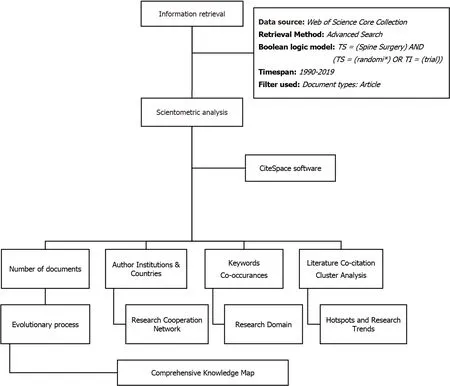

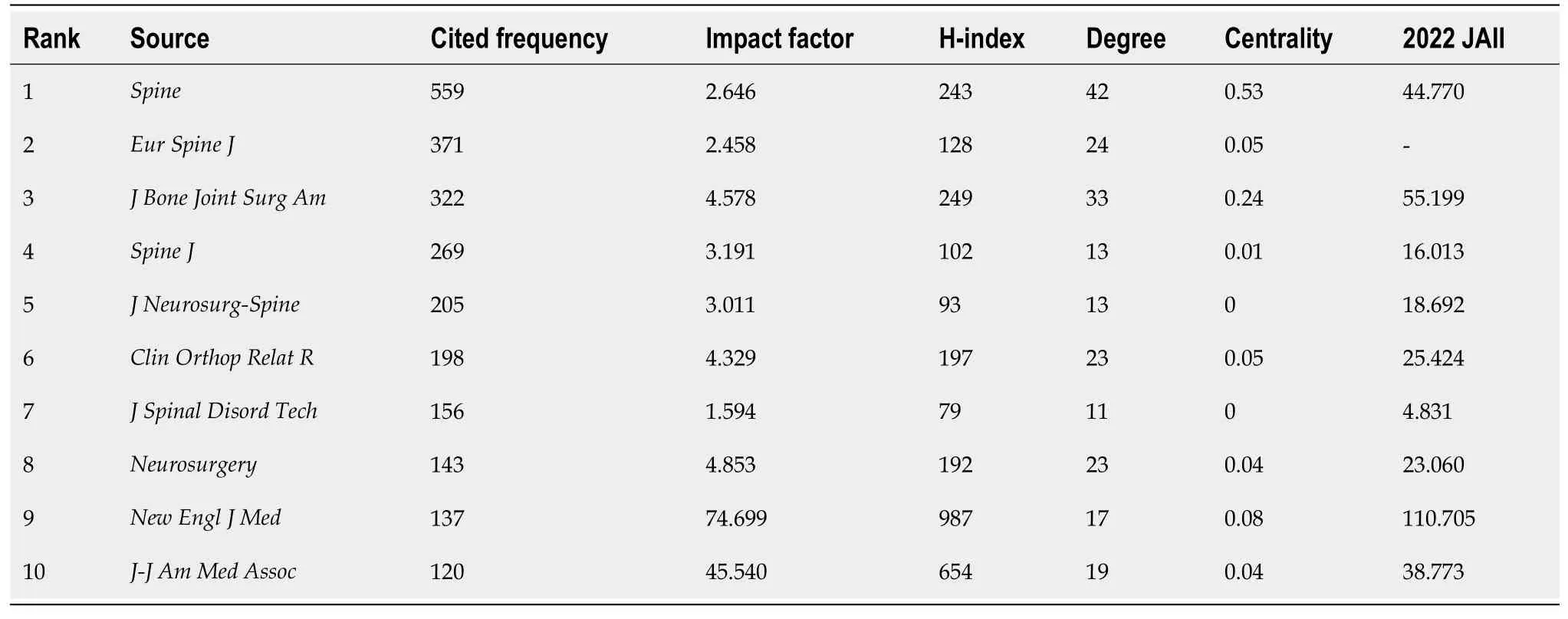
Scientific cooperation network analysis
The author co-occurrence network map had 245 nodes,and 1128 connections with a network density of 0.0377 (Figure 4). On the whole,the authors in the network map had a fair connection strength among each other; however,there were some poorly connected islands of author groups that need global strengthening (Figure 4).
The research cooperation group with the closest communication was from Weinstein JN,Deyo RA,Atlas SJ,Ware JE and Fairbank JCT. The details of the top 10 authors who published RCTs on spinal surgery are shown in Table 2. Weinstein JN published the highest number of RCTs in spinal surgery,with a degree value of 35 and H-index of 68. His research spanned several areas in spinal surgery. Weinstein JN was principal investigator in various outcome trials involving disc herniation,spinal stenosis and degenerative spondylolisthesis,and investigated the role of surgery and conservative therapy in these conditions. He also did a lot of work on pain and first developed the lumbar radiculopathy model. Deyo RA (degree:55; H-index:116),being a member of the Cochrane Review Group on Back Disorders,conducted trials mostly on clinical intervention and patient aids for spinal surgery. Atlas SJ concentrated on sciatica and spinal stenosis in spinal surgery. The other two authors in the top five were Ware JE and Fairbank JCT,who did pioneering works on quality of life measures in spinal surgery and Oswestry Disability Index,respectively.
Then the sun began to rise, and when she saw the red dawn she went to the end of the bed and looked at it, and as she was watching the sun rise, out of the window, she thought, Ha! could I not make the sun and man rise? Husband, said she, poking32 him in the ribs33 with her elbows, wake up
Our study had a few limitations. The core data used for analysis were from the WoS Core Collection database anddatabase. We had an English language restriction for the published RCTs. We did not consider the grey literature such as unpublished conference documents,scientific reports,dissertations,scientific archives,,for analysis of the research trend. From a visual analysis perspective,all the available information was not incorporated into the knowledge map.
He often went to visit the witch, whom he believed to be Princess Signy, and one day he asked: Don t you think we might be married before long? Yes, said she, quite pleased, I am quite ready to marry you whenever you like
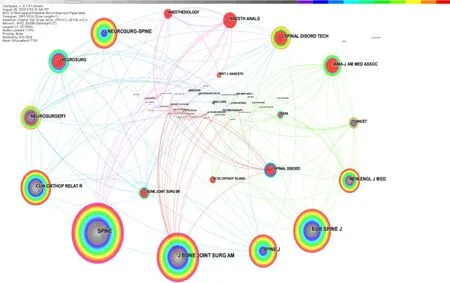
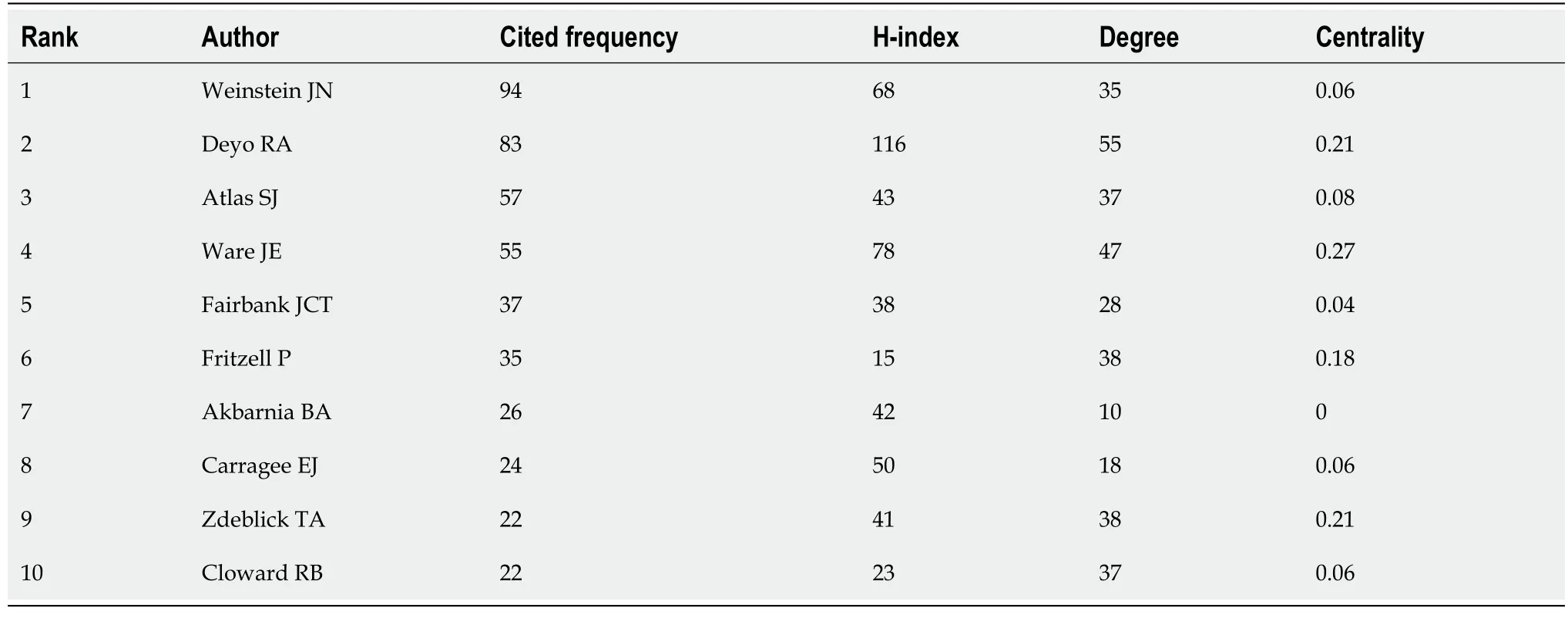
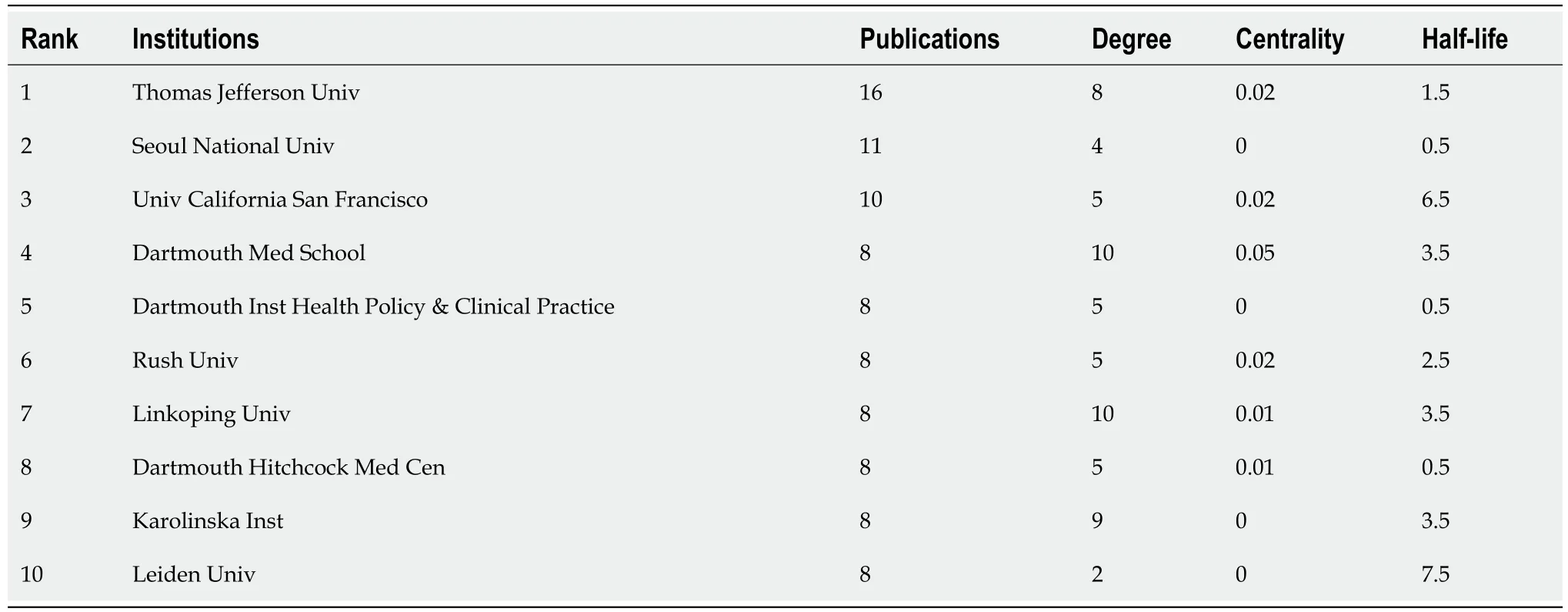
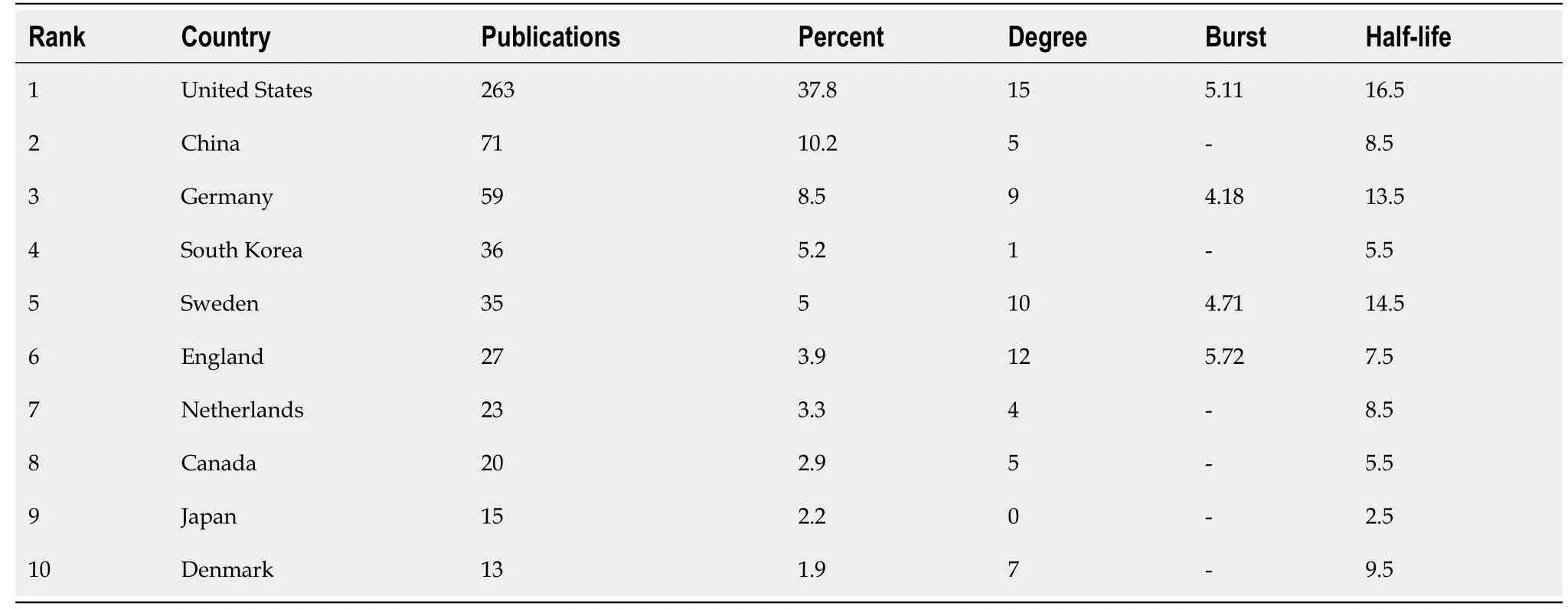
Keyword analysis
We analyzed the co-occurrence network of the key words used in the field and their summary and classification based on research direction and frequency is given in Table 5. The keywords were manually sorted into five major topics. The first topic included localizing keywords such as “spine (133)”,“l(fā)umbar spine (42)” and “cervical spine (7)”. It focused mainly on the region of the spine involved in RCTs. Topic 2 included keywords related to disease pathology involved in RCTs such as “spondylolisthesis (11)”,“disease (9)”,“spinal disease (7)”,degenerative spondylolisthesis (5)”,The third topic of keywords involved symptomatology such as “l(fā)ow back pain (104)”,“pain (36)”,“radiculopathy (10)” and “sciatica (7)”. The fourth topic involved keywords related to management methods such as “surgery (208)”,“fusion (91)”,“spinal surgery (87)”,“outcome (79)”,“management (62)”,“complications (59)”,The fifth topic was concerned with the outcome measure keywords such as “efficacy (40)”,“reliability (9)”,“risk (6)”,“safety (6)”,
Co-citation analysis
It is a common practice for the researchers to cite the evidences from the results of RCTs in their research work as references. Scientific development is made through such mutual citations of scholarly works in the field.[16] The citation network of RCTs published in the 1990s looks relatively sparse while the network of RCTs published around the 2000s and 2010s look denser (Figure 7). It is also noted that highly cited RCTs are from the middle and late periods. Based on Figure 7,the top 10 RCTs cited by frequency are presented in Table 6. The frequency of citation of these RCTs was limited to the mutual citations between the 696 included RCTs,which was different from the citation frequency available in WoS. The article “Surgicalnonoperative treatment for lumbar disk herniation - The Spine Patient Outcomes Research Trial (SPORT) observational cohort” by Weinstein JN is the most frequently cited RCT in spinal surgery. This pioneering work established the equivalence in the effectiveness of surgical and conservative treatment for lumbar disc herniation. The burst value in the table shows that these articles had been the focus of research for a period of time. The highest burst value was noted for the same article mentioned above by Weinstein JN. It is also noted from the table that,andeach contributed two articles to the top 10 list. Of the top 10 articles,three RCTs compared surgical and conservative treatment for lumbar disc disease,three RCTs evaluated the role of growth rods in early-onset scoliosis,and three RCTs compared the results of fusion and arthroplasty for cervical disc disease.
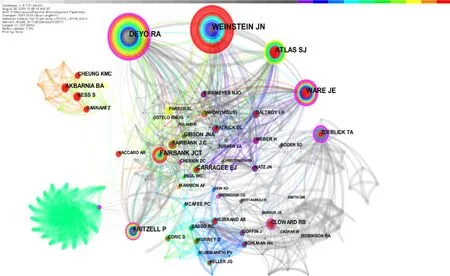

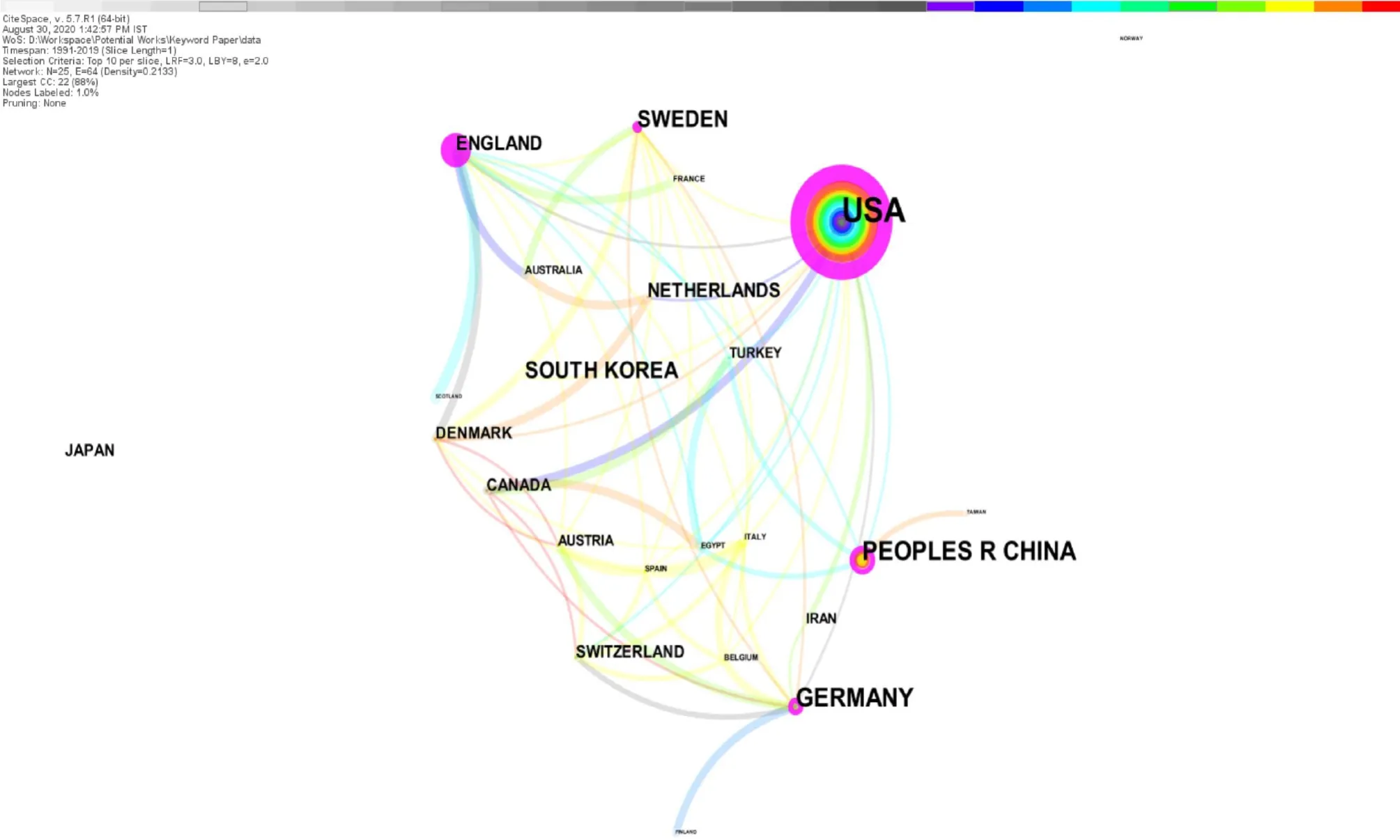
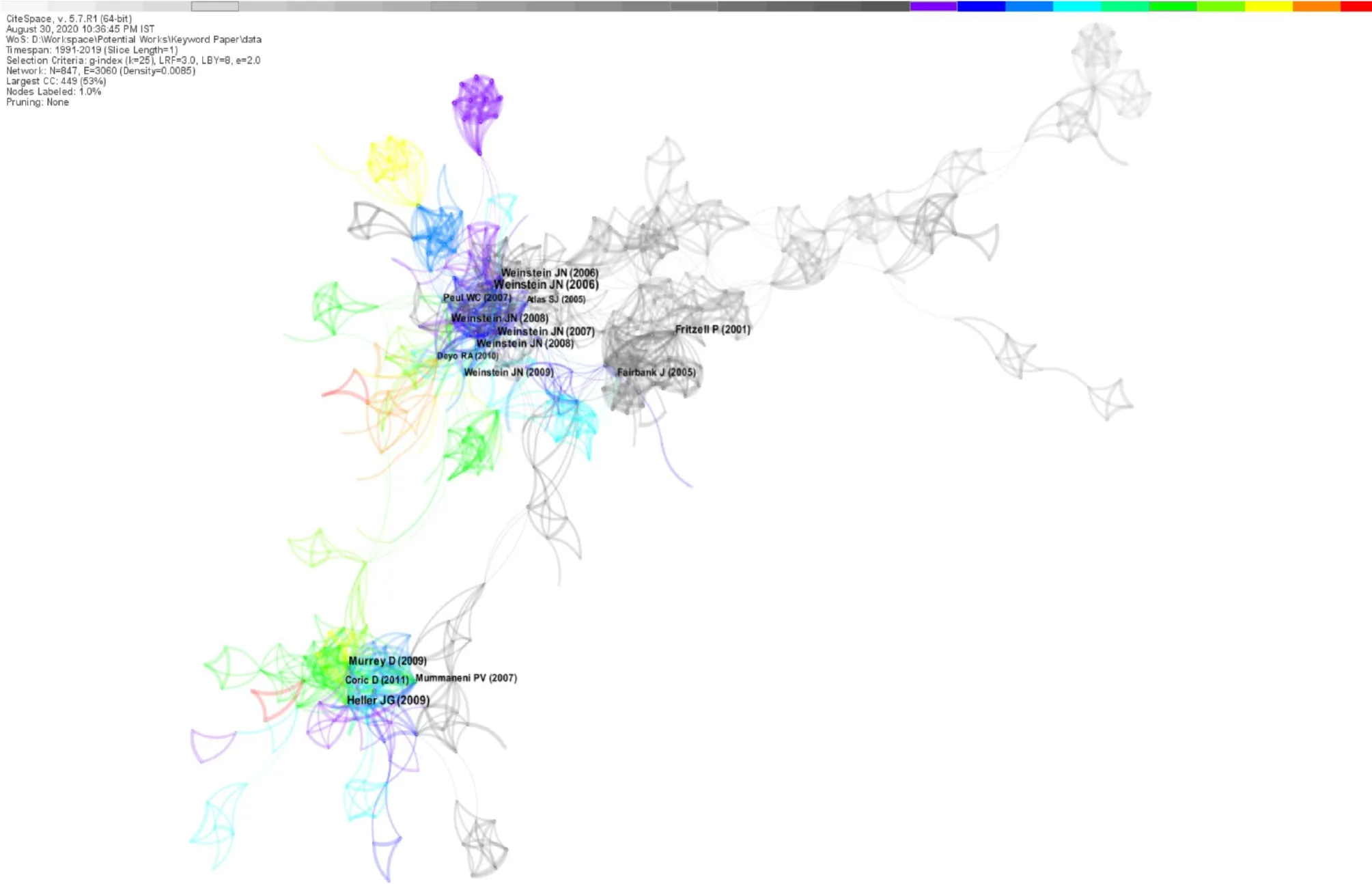
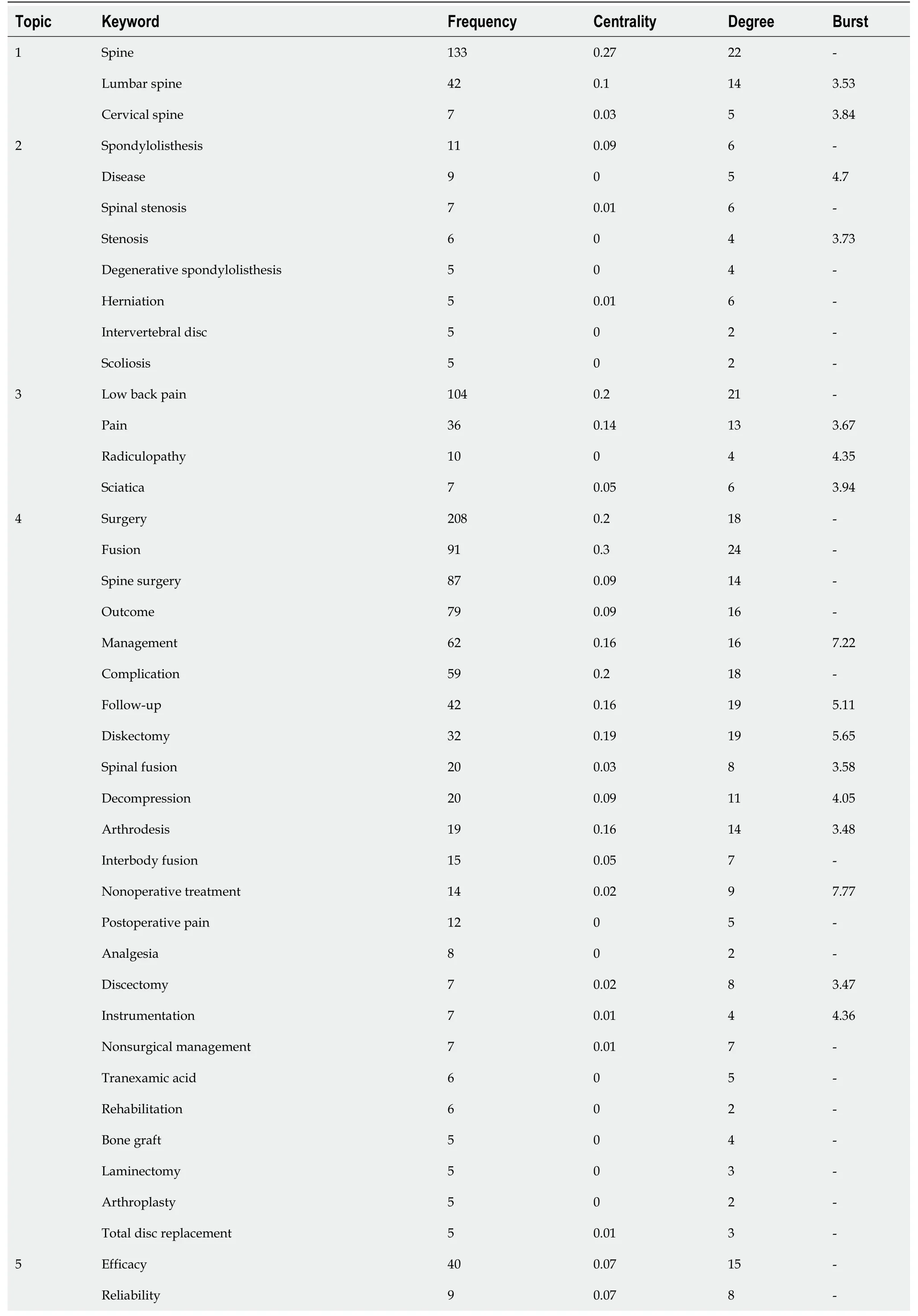

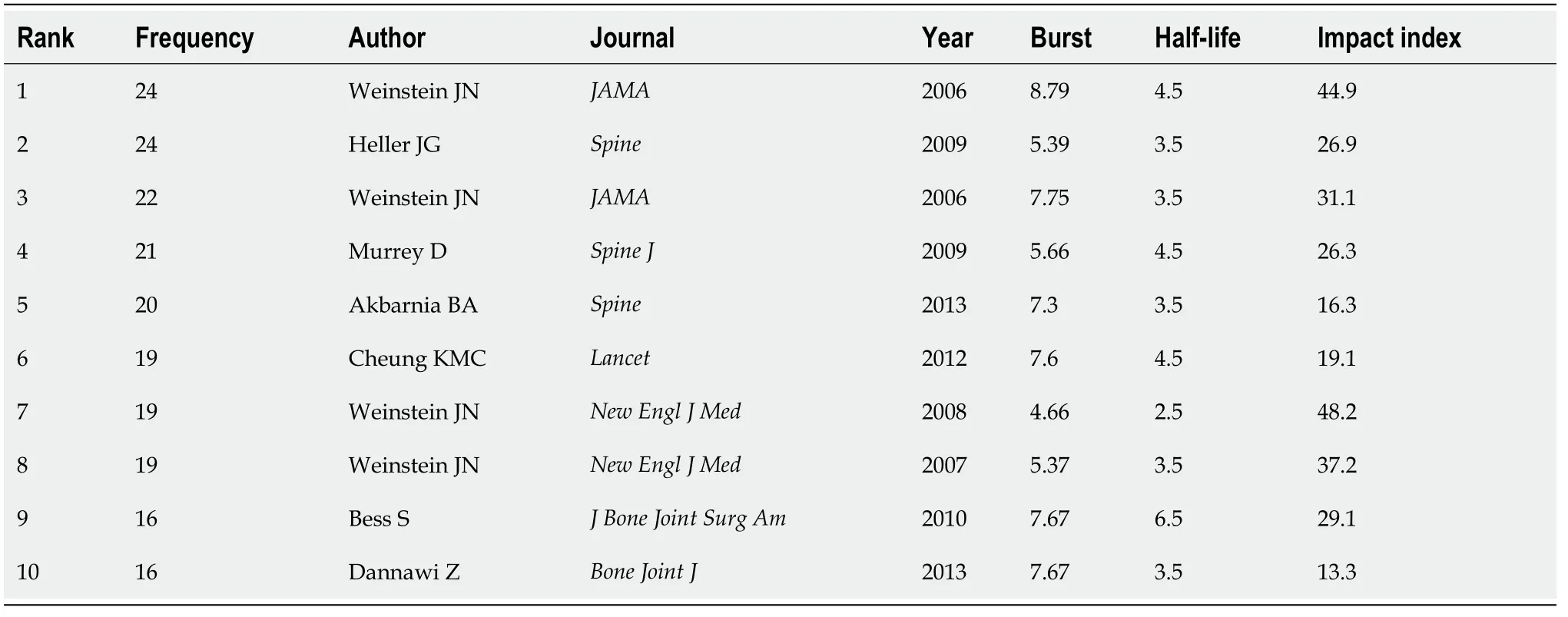
Cluster analysis of co-citation network
Using exploratory data mining techniques,analysis of the data clusters enables the identification of important topics,and their evolutionary trends. A comprehensive clustering of the RCTs published in a given theme is done in cluster analysis and an objective projection of the principle content is visualized[17]. The RCT cluster map on spinal surgery is depicted in Figure 8. The time needed for clustering from far to near is depicted as the color of the clusters from cold to warm. The articles with high burst values are presented as cluster blocks with red nodes. The higher the presence of red nodes in a cluster it denotes that the clustered topic is a research frontier and hot spot in the field. We summarized the information of the clusters in Table 7. Considering the cluster analysis from Figure 8 and Table 7,“spinal stenosis”,“anterior cervical discectomy and fusion”,“degenerative disc disease” and “minimally invasive decompression” were the hotspots in the field of spinal surgery and considered as the potential research frontiers that need further research.
Category co-occurrence analysis
Based on the category co-occurrence analysis,one can intuitively understand the main subjects of research in the field of concern[18]. The categories used for classification were taken from the WoS core collection database. As shown in Figure 9,the highlighted circle on the nodes indicate that it has high-intermediate values of centrality. Table 8 gives the list of top 10 categories in spinal surgery with high co-occurrence frequency. From Figure 9 and Table 8 it is evident that the research categories involve multiple disciplines and fields. The comprehensive knowledge map in spine surgery research from 1990 to 2019 is depicted in Figure 10.
After supper, they returned as they had come to the ebony room, where he was compelled to look on while his companions played interminable games of chess, and not until he was nearly dying of weariness did they, slowly and ceremoniously as before, conduct him to his sleeping apartment
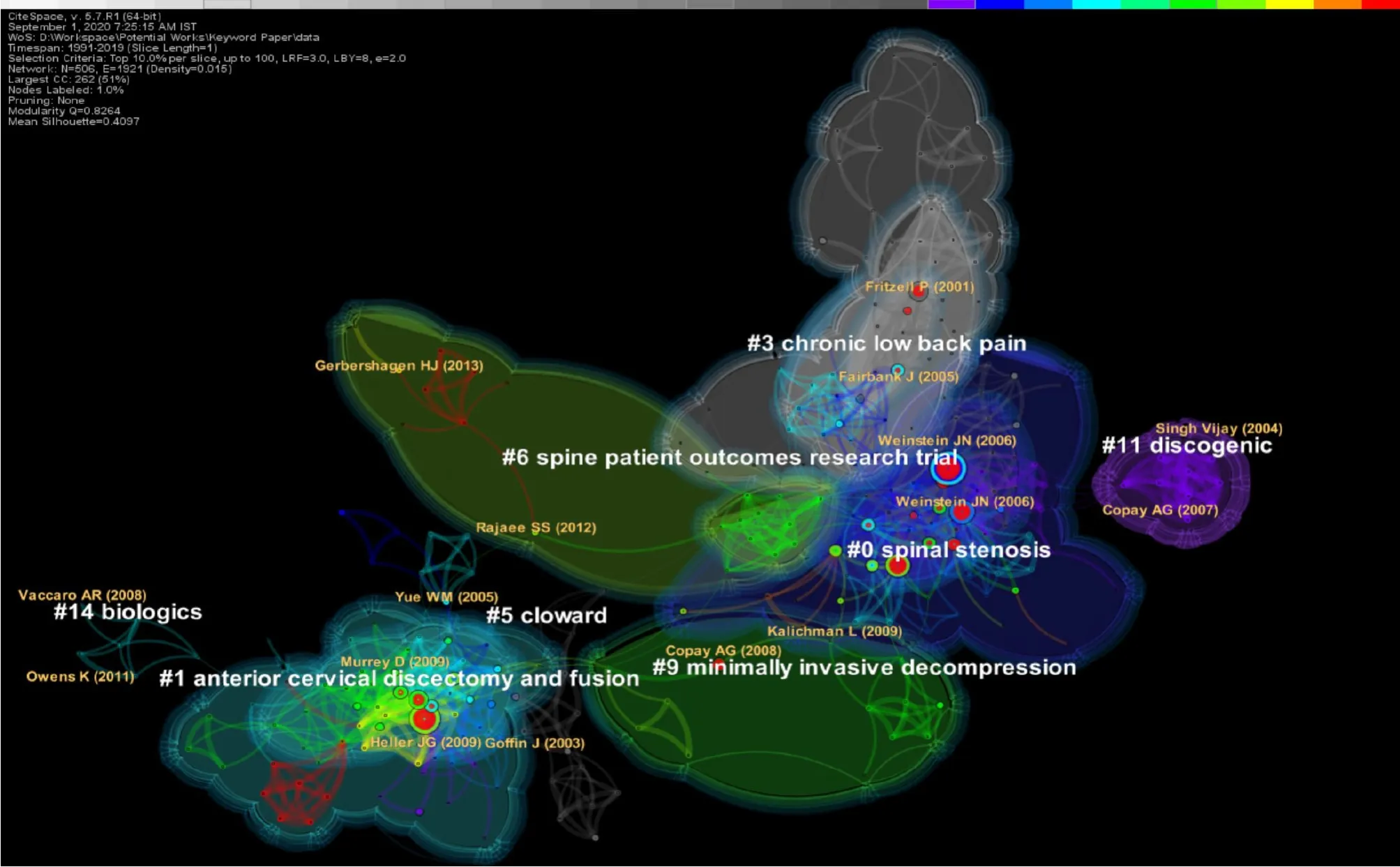
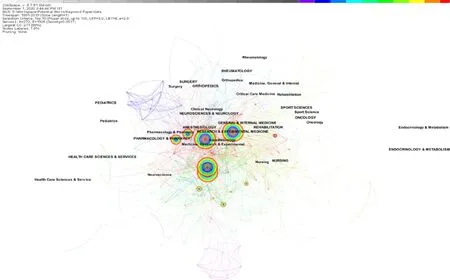
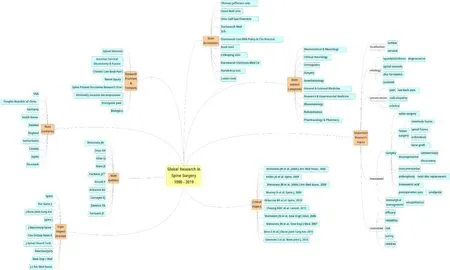
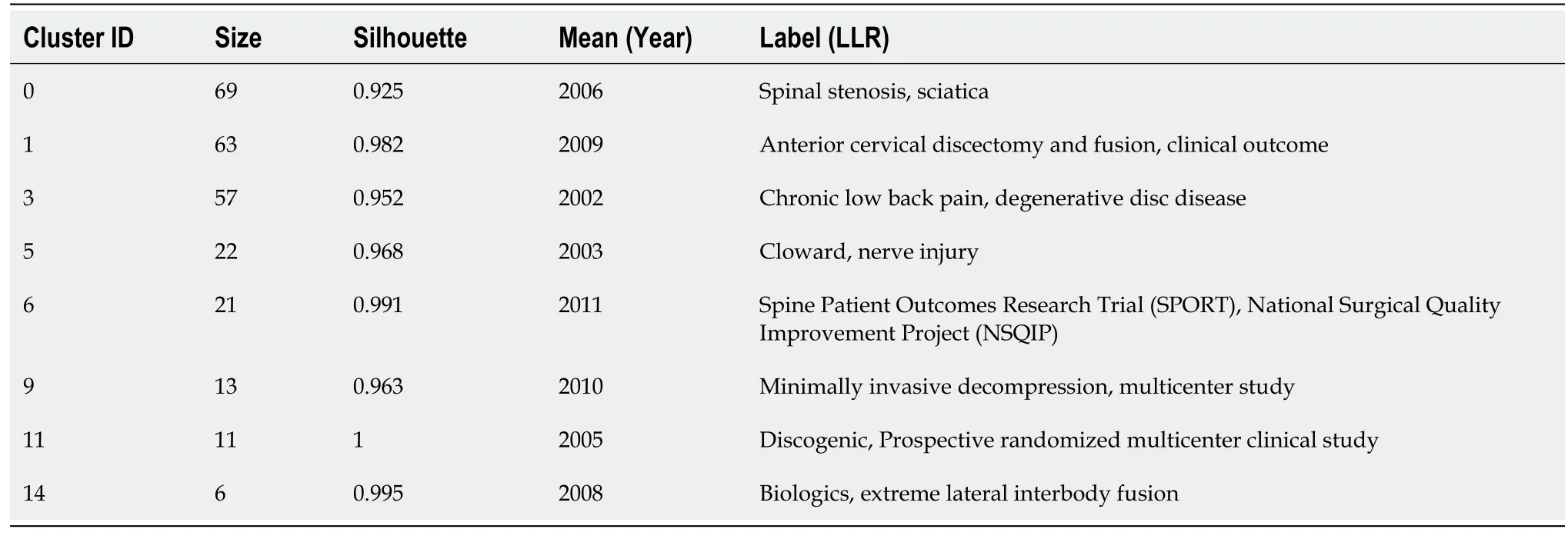
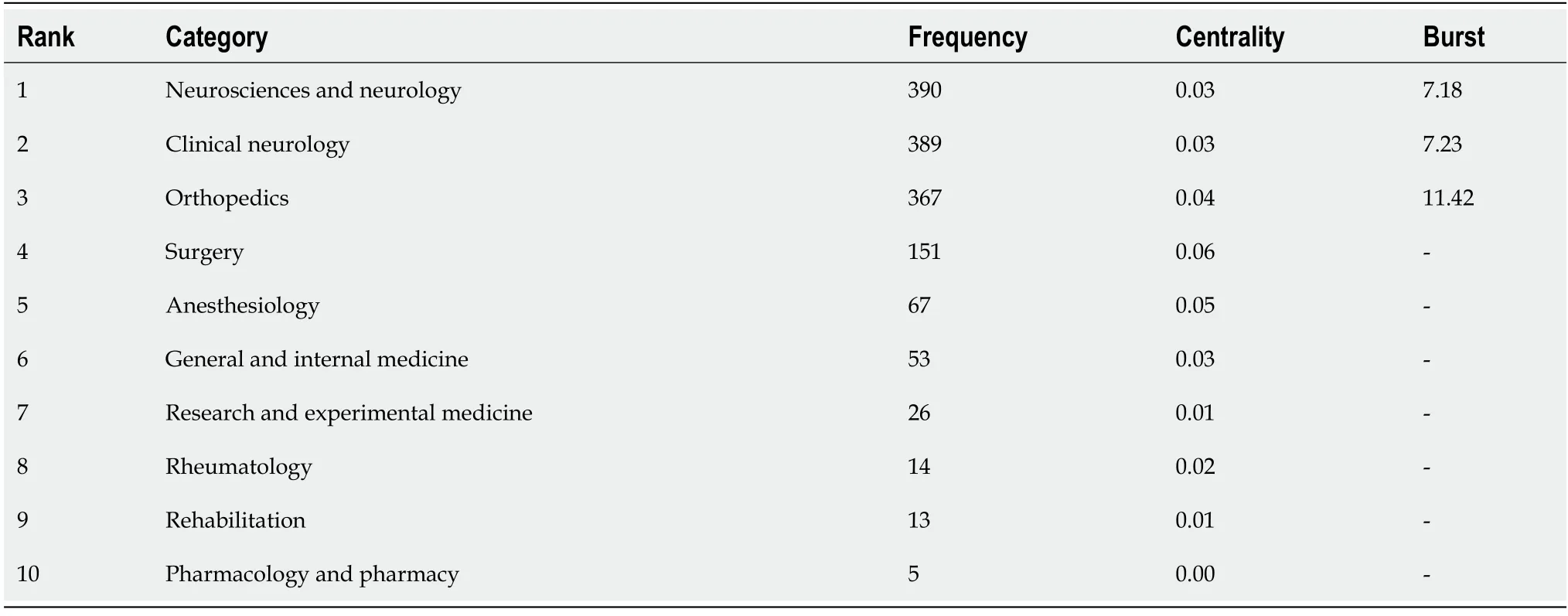
DlSCUSSlON
We noted a rising trend in the number of published studies on spinal surgery based on the research outputs analyzed. We also noted an increase in the academic activities in the field of spinal surgery through a proportionate increase in the number of proceeding papers and meeting abstracts. This denoted an increase in international attention for innovation in the field of spinal surgery and improvisation of the existing standards of care. With the advances in technology,we noted an increase in survival period and proportionate increase in the aging population[19],which raises a concern to increase our focus on degenerative disorders of the spine.
Some of the landmark papers in spinal surgery research were published inand,which were in the publishing field for more than a century with a high academic reputation. They have laid a foundation for spinal surgery research and paved the way for the field-specific journals to cater to the subsequent research in spinal surgery. Among the specific journals recognized in the field,andwere affiliated with various regional,national,international societies and associations and have been in publication for > 40 years and have contributed to progress in the field of spinal surgery. Most of the hotspots in spinal surgery arose from RCTs published in these high-impact journals. Researchers interested in spinal surgery should closely follow the high-quality trials published by these journals in real time.
Our revies explored the research cooperation in spinal surgery from three perspectives,namely,small-author cooperation network,intermediate-institutional cooperation network,and large-national cooperation network. We noted academic cooperation mostly among the predominant institutions in a particular country and prominent authors in an institution. In the publication of RCTs,developed nations like the United States and Germany were leading the way,while in developing countries like China,although they had more publications,they were not from prominent institutions or authors. Hence,increased research collaboration with the developing countries will be conducive to advancement of spinal surgery.
The potential research topics and emerging trends have been revealed by analyzing the keyword cooccurrences and literature co-citations in spinal surgery. Keywords are one of the research data that gives an idea about the main themes of research in a particular article. With the advanced scientometric techniques such as text mining and keyword co-occurrence analysis,we can visualize the research trends in a field and identify the hotspots of research[20]. From the result of such analysis,the five main research topics in spinal surgery include regional localization such as cervical and lumbar surgery; disease pathology like spondylolisthesis,stenosis,intervertebral disc,and scoliosis; surgical treatment methods like fusion surgery,decompression surgery,instrumentation surgery,and arthroplasty; outcome measures like efficacy,risks,safety and reliability of the treatment methods.
Literature co-citation analysis noted that spinal stenosis,anterior cervical discectomy and fusion,degenerative disc disease,and minimally invasive decompression are the current hotspots and research frontiers. With the global aging population > 60 years expected to outnumber children younger than 5 years by 2020[19],spinal stenosis and its fusion procedures have become one of the major research frontiers. With the drive for minimally invasive surgical procedures considering their lower morbidity with minimal hospitalization period[21],much of the research efforts are being directed towards making such surgical procedures safer for these aging patients and simpler for surgeons.
Spinal surgery has made technological advancements in recent years in terms of intraoperative imaging,3D navigated operations,materials with nanoscale architecture,[22-25]. Material science research has brought about a revolution in the instrumentation options involved in spinal surgery. The development of materials with high biocompatibility and biomechanical characteristics comparable to those of the native has resulted in a faster and more physiological ossification when used in spinal fusion[26]. Hence,topics such as discogenic pain,nerve injury,clinical outcome,biologics and extreme lateral interbody fusion (XLIF) have been the important research topics directing the progress of spinal surgery.
To assess the potential research domains of randomized controlled trials (RCTs) for the past three decades (1990-2019),along with their research networks,and to identify the hot topics for future research.
The co-institutional network is presented in Figure 5,and consisted of 95 nodes and 118 links with a network density of 0.0264. There was weak collaboration among the institutions globally,but the network of domestic institutions seemed closer. The top 10 list of institutions that published maximum RCTs are listed in Table 3. Thomas Jefferson University (16 RCTs),Seoul National University (11 RCTs),University of California San Francisco (10 RCTs),Dartmouth Medical School (8 RCTs),and Dartmouth Institute of Health Policy & Clinical Practice (8 RCTs) were the predominant institutions with major contributions. These institutions made a central contribution to the RCTs in spinal surgery. Six of the top 10 institutions were from the United States (3 universities,2 institutes,and 1 School),Sweden came second with two institutions (1 university and 1 institute). The contribution of United States and Sweden in the field of spinal surgery has been shown to be exceptional in this analysis.
Our analysis revealed the key areas of ongoing research in spinal surgery to advance the management of spinal diseases like spinal cord injury,spondylolisthesis,spinal stenosis,intervertebral disc disease,and scoliosis. Since arthroplasty is a sought-after field of research in the orthopedic forum,the spine is no exception. However,recent trials are being conducted on surgical treatment methods like fusion surgery,decompression surgery,instrumentation surgery,and arthroplasty. With the current abundance of evidence on novel treatment methods using regenerative principles and mesenchymal stromal cells and their derivatives to combat various inflammatory and degenerative disorders,we except more upcoming trials investigating their role in spinal surgery too. The current research hotspots are presented in the PICO format as Table 9.
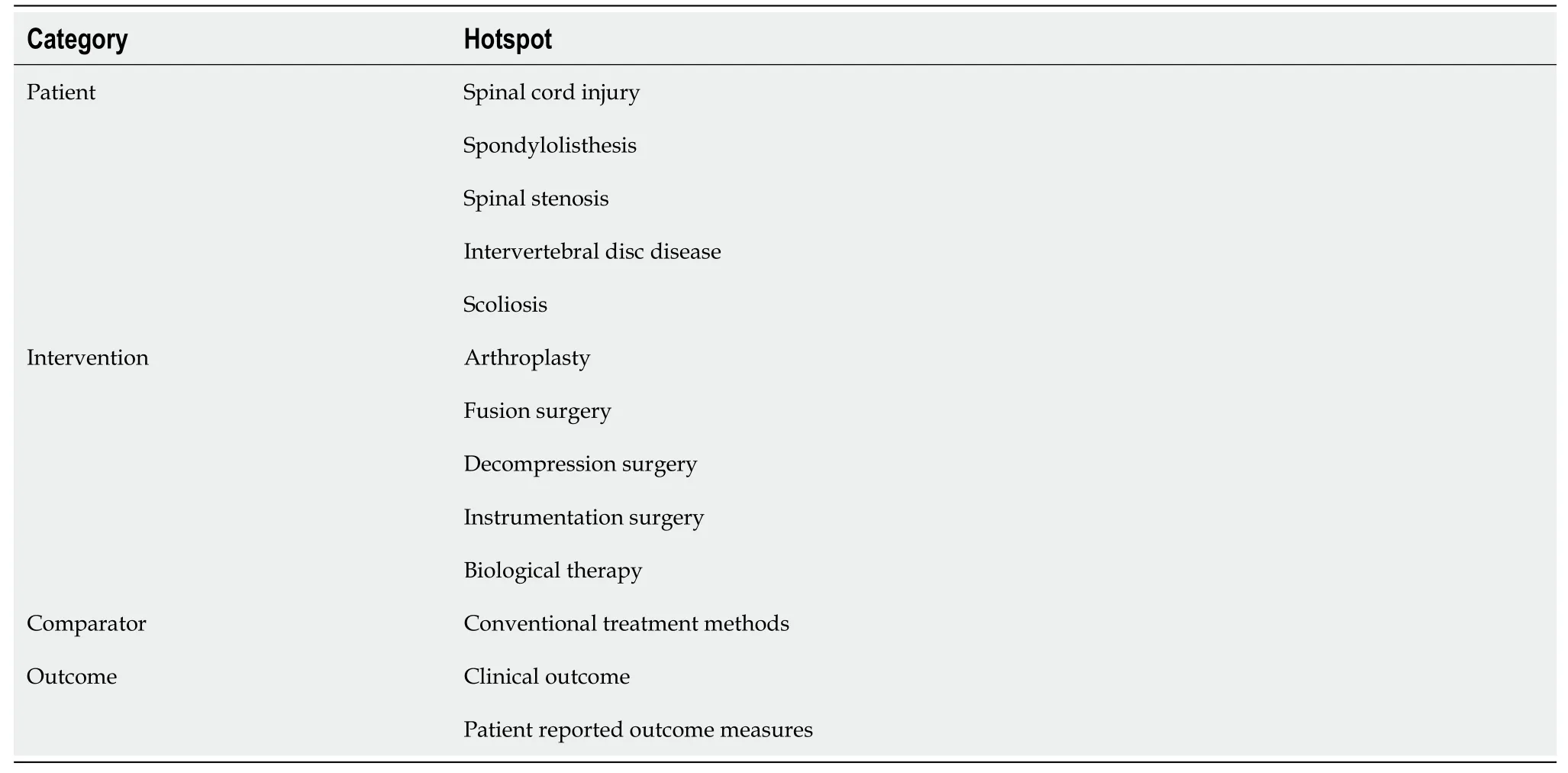
CONCLUSlON
Spinal surgery research was extensive with multidisciplinary methods and technologies and its development needs the involvement of researchers from various fields. We recommend strengthening research cooperation among the developed and developing nations. This study provides an overview of research fields in spinal surgery through a systematic and comprehensive scientometric analysis of published RCTs and identified the emerging trends and research hotspots. It was evident from the identified hotspots that degenerative disorders remain the potential frontier in spinal surgery that holds the promise for future advancements.
ARTlCLE HlGHLlGHTS
Research background
Spinal surgery is evolving and in the due course of its evolution,it is useful to have a comprehensive summary of the process to have a greater understanding to refine our future directives.
Arms wrapped around her backpack, Mary Lou came down the school steps. The taunting7 began - rude, biting comments and jeering8 from the girls. I paused, then joined right in. My momentum9 began to pick up as I approached her. Nasty, mean remarks fell unabated from my lips. No one could tell I’d never done this before. The other girls stepped back and became my cheerleaders. Emboldened10, I yanked the strap11 of her backpack and then pushed her. The strap broke, Mary Lou fell and I backed off. Everyone was laughing and patting me. I fit in. I was a leader.
Research motivation
With the multiple domains of research on the spine,it has become difficult for surgeons to find the potential hotspots in research or identify the emerging research frontiers.
Research objectives
One day he was walking down a broad road when he was stopped by a handsome man he had never seen before, who, little as Don Giovanni knew it, was the devil himself
Research methods
A comprehensive and systematic analysis of all the RCTs published on spinal surgery from 1990 to 2019 retrieved from the Web of Science Core Collection database. Scientometric and visual analysis of their characteristics,cooperation networks,keywords,and citations were made using CiteSpace software.
Research results
A total of 696 RCTs were publ ished on spinal surgery from 1990 to 2019; of which,the United States (n =263) and China (n = 71) made a significant contribution. Thomas Jefferson University (n = 16) was the leading contributor to RCTs. Weinstein JN was the most cited author in the field followed by Deyo RA.Spine (n = 559) remained the top-cited journal for RCTs on spinal surgery. On literature co-citation analysis,spinal stenosis,anterior cervical discectomy and fusion,degenerative disc disease,and minimally invasive decompression were identified as the hotspots and potential research frontiers.
For a few moments he stood there, wondering what was to be done, then there darted8 into his head some words of a spell which he had once heard a wizard use, while drinking from the river
In the co-country map depicted in Figure 6,25 nodes and 64 links were noted with a network density of 0.2133. From a global standpoint,the density of the network as depicted in Figure 6 was weak with few connections between the countries in terms of conducting RCTs in spinal surgery. Further global cooperation is needed for research in spinal surgery. With the rising demand for advancement in the management of spinal ailments,countries must try to solve the problem by coordinating their efforts together for conducting RCTs. Table 4 shows the top 10 countries publishing RCTs in spinal surgery. The United States has contributed most to the field of spinal surgery,with 263 RCTs,accounting for 37.8% of the global contribution. Other countries contributing to the publication of RCTs in spinal surgery included China (71 RCTs,10.2%),Germany (59 RCTs,8.5%),South Korea (36 RCTs,5.2%),and Sweden (35 RCTs,5%). Developed nations like the United States had a cold tone in their node circle whereas China,as a developing country,which conducted RCTs later than the developed nations,had a warm tone in their nodes (Figure 6). Despite having 71 RCTs published by China,none of their authors or institutions were in the top 10 list of contributors. It indicates that despite the late start of research in the field in China,it has developed at a rapid rate to achieve the current number of published RCTs.
Research conclusions
Research cooperation among developed and developing nations remains crucial and needs to be strengthened. It was evident from the identified hotspots that extending the frontiers in the management of degenerative disorders of the spine through further research holds the potential for advancement in spinal care.
Research perspectives
Our analysis revealed the key areas of ongoing research in spinal surgery to advance the management of spinal diseases like spinal cord injury,spondylolisthesis,spinal stenosis,intervertebral disc disease,and scoliosis. Since arthroplasty is a sought-after field of research in the orthopedic forum,the spine is no exception. However,recent trial are being conducted on surgical treatment methods like fusion surgery,decompression surgery,instrumentation surgery,and arthroplasty. With the current abundance of evidence on novel treatment methods using regenerative principles and mesenchymal stromal cells and their derivatives to combat various inflammatory and degenerative disorders,we except more upcoming trials investigating their role in spinal surgery.
The database search recovered 696 RCTs published on spinal surgery from the global literature from 24 256 articles that included 20 458 non-RCTs,2206 reviews,583 proceedings papers,and 313 meeting abstracts from 1990 to 2019. Figure 2 shows the output of the RCTs published in the field of spinal surgery. The first two decades (1990-2009) had an average of three RCTs published per year,which later increased to 51 RCTs per year in the last decade (2010-2019). There was an overall rising trend in the scientific output on spinal surgery (Figure 2). This increasing trend in publication of RCTs shows the increased attention paid in the field of spinal surgery by surgeons and researchers to improve the standard of care. It is also evident from Figure 2 that the other types of research communication documents such as original articles,reviews and proceedings papers,and meeting abstracts also had a proportionate growing trend.
Muthu S,Jeyaraman M and Jeyaraman N performed the data collection and compiled the paper.
All authors report no relevant conflict of interest for this article.
The authors have read the PRISMA 2009 Checklist,and the manuscript was prepared and revised according to the PRISMA 2009 Checklist.
She had no sooner done so but her godmother turned them into six37 footmen, who skipped up immediately behind the coach, with their liveries38 all bedaubed with gold and silver, and clung as close behind each other as if they had done nothing else their whole lives. The Fairy then said to Cinderella:
This article is an open-access article that was selected by an in-house editor and fully peer-reviewed by external reviewers. It is distributed in accordance with the Creative Commons Attribution NonCommercial (CC BYNC 4.0) license,which permits others to distribute,remix,adapt,build upon this work non-commercially,and license their derivative works on different terms,provided the original work is properly cited and the use is noncommercial. See:https://creativecommons.org/Licenses/by-nc/4.0/
The body, she knew, could do no harm to any one, but the spirit could pursue the lonely wanderer, attach itself to him, and demand to be carried to the churchyard, that it might rest in consecrated ground
India
Sathish Muthu 0000-0002-7143-4354; Madhan Jeyaraman 0000-0002-9045-9493; Naveen Jeyaraman 0000-0002-4362-3326.
Wu YXJ
Kerr C
Yuan YY
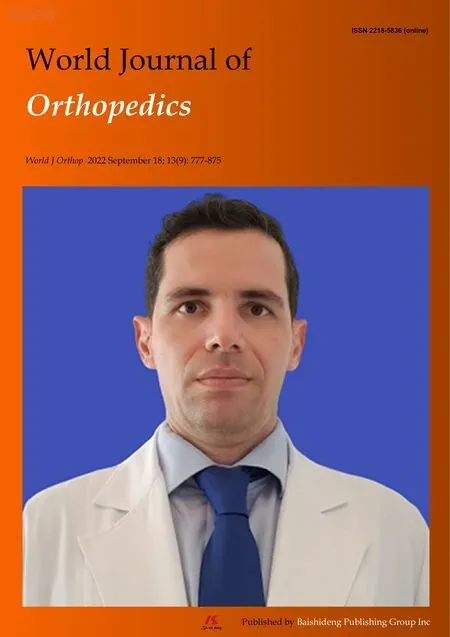 World Journal of Orthopedics2022年9期
World Journal of Orthopedics2022年9期
- World Journal of Orthopedics的其它文章
- Calcium pyrophosphate dihydrate crystals in a 9-year-old with osteomyelitis of the knee:A case report
- Return to work following shoulder arthroplasty:A systematic review
- Fragility of statistically significant findings from randomized clinical trials of surgical treatment of humeral shaft fractures:A systematic review
- Revision anterior cruciate ligament reconstruction:Return to sports at a minimum 5-year follow-up
- Short arm cast is as effective as long arm cast in maintaining distal radius fracture reduction:Results of the SLA-VER noninferiority trial
- Histological difference in ligament flavum between degenerative lumbar canal stenosis and non-stenotic group:A prospective,comparative study
